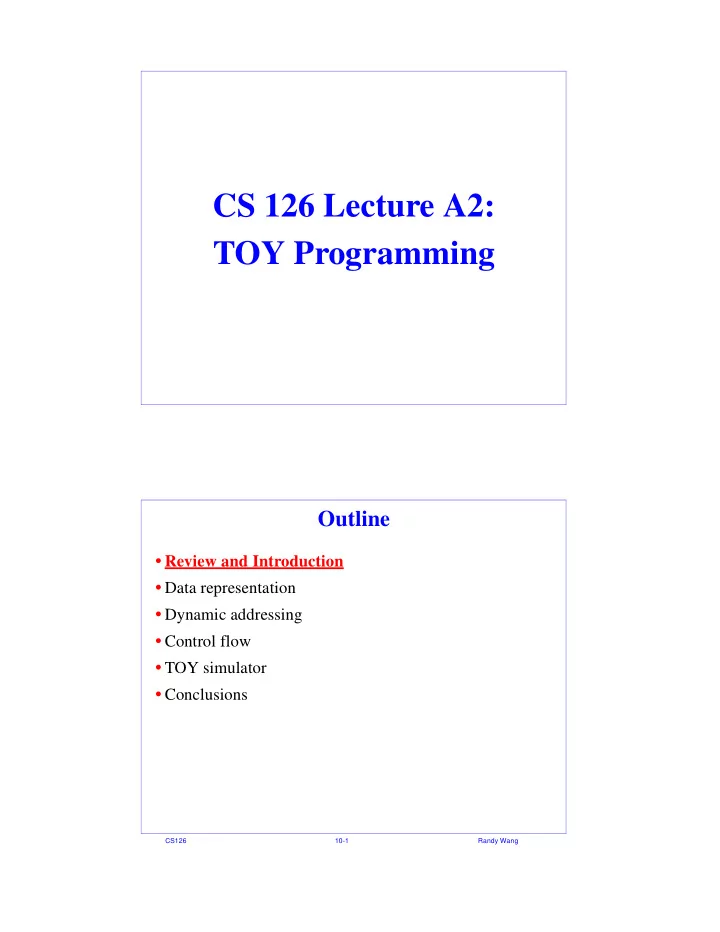

CS 126 Lecture A2: TOY Programming Outline • Review and Introduction • Data representation • Dynamic addressing • Control flow • TOY simulator • Conclusions CS126 10-1 Randy Wang
What We Have Learned About TOY • What’s TOY, what’s in it, how to use it. - von Neumann architecture • Data representation - Binary and hexadecimal • TOY instructions - Instruction set architecture • Example TOY programs - Simple machine language programming CS126 10-2 Randy Wang What We Haven’t Learned • How to represent data types other than positive integers? • How to represent complex data structures at machine level? • How to make function calls at machine level? • What’s the relationship among TOY, C programming, and “real” computers? CS126 10-3 Randy Wang
Outline • Review and Introduction • Data representation • Dynamic addressing • Control flow • TOY simulator • Conclusions CS126 10-4 Randy Wang Represent Negative Numbers Using “Two’s Complement” • Represent -N with an n -bit 2’s complement: 2 n - N • To calculate -N , start with N , flip bits, and add 1 CS126 10-5 Randy Wang
Examples CS126 10-6 Randy Wang Arithmetic • Addition is carried out as if all numbers were positive 15 • Subtraction -N is done with addition of N CS126 10-7 Randy Wang
Nice and Not-So-Nice Properties • Nice properties - 0 is 0 - -0 and +0 are the same • Not-so-nice property - Can represent one more negative number than positive numbers - With n bits, can represent: 2 n-1 - 1 positive numbers ( 2 n-1 - 1 is maximum) 0 2 n-1 negative numbers (- 2 n-1 is minimum) - A2-3 of course reader is wrong! (Replace 16s with 15s) • Alternatives other than 2’s complement exist CS126 10-8 Randy Wang Other Primitive Data Types • “double” type, “long long” type (for most compilers) CS126 10-9 Randy Wang
Outline • Review and Introduction • Data representation • Dynamic addressing • Control flow • TOY simulator • Conclusions CS126 10-10 Randy Wang The Need for Dynamic Addressing int a; int *p; 1 3 int a[100]; 2 p = (int *) malloc(sizeof *p); • All we have so far: “hard-wired” addresses inside instructions ( R1<-MEM[D0]) • Many cases where guessing address at compile-time is impossible - case 1: possible for compiler to hard-wire address of a - case 2: difficult for compiler to hard-wire address of a[i] - case 3: impossible for compiler to guess address at p • Solution: - Compute address at run time - Put address in a register - Augment instruction format to use address register CS126 10-11 Randy Wang
Review: Instruction Format 2 CS126 10-12 Randy Wang Indexed Addressing 0 1 • Example: A923 means MEM[R[2]+R[3]]<-R[1] (9 is binary 1001) CS126 10-13 Randy Wang
Why “Stealing” One Bit is OK 0 1 • We only have 8 registers • Only three bits are necessary • But 4 bits allocated to dest register field • So we can “steal” 1 bit CS126 10-14 Randy Wang C Program for Fibonacci Array #include <stdio.h> do { a[k] = a[i]+a[j]; main() i++; { j++; int a[16]; k++; int n, i, j, k; n--; } while (n > 0); n = 15; a[0] = 1; for (i = 0; i < 16; i++) { a[1] = 1; printf("%d ", a[i]); i = 0; } j = 1; printf("\n"); k = 2; } • We will see how to implement the line in red using indexed addressing in TOY CS126 10-15 Randy Wang
TOY Version of Fibonacci Program p = &a[0]; CS126 10-16 Randy Wang Food for Thought • Self-modifying programs • Special purpose computer -> general purpose computer -> stored program computer -> self-modifying stored program computer • Are some machines intrinsically more powerful than others?? Stay tuned. CS126 10-17 Randy Wang
Outline • Review and Introduction • Data representation • Dynamic addressing • Control flow • TOY simulator • Conclusions CS126 10-18 Randy Wang Branches and Looping CS126 10-19 Randy Wang
The Halting Problem • Why doesn’t the compiler detect infinite loops and tell me? CS126 10-20 Randy Wang Function Calls • Functions can be written and used by different people (one possibility) CS126 10-21 Randy Wang
Example Function Takes care of b==0 CS126 10-22 Randy Wang Example Caller CS126 10-23 Randy Wang
Function Call Demo CS126 10-24 Randy Wang The Use of Registers vs. Memory for Function Calls • Stack is implemented using main memory • Review: - Call: push environment (registers and PC) - Call: push function parameters - Inside a function: look for parameters on the stack - Return: restores environment by popping stack • Registers can still be used as optimizations CS126 10-25 Randy Wang
Outline • Review and Introduction • Data representation • Dynamic addressing • Control flow • TOY simulator • Conclusions CS126 10-26 Randy Wang Availability • Better yet, download java version from announcement page • Edit “toy.html”, reopen it in browser CS126 10-27 Randy Wang
TOY Simulator (Part 1:fetch, incr, decode) Initialize memory by reading from standard in decode Increment Fetch CS126 10-28 Randy Wang TOY Simulator (Part 2: execute) CS126 10-29 Randy Wang
TOY Dump CS126 10-30 Randy Wang Outline • Review and Introduction • Data representation • Dynamic addressing • Control flow • TOY simulator • Conclusions - Relationships among machine language programming, C programming, TOY machine, and “other” machines CS126 10-31 Randy Wang
Engineering and Theoretical Implications of Simulator • Theoretically, any von Neumann machine can simulate any other von Neumann machine--all of them have the same “power”!! (More later) CS126 10-32 Randy Wang What We Have Learned • Two’s complement - How to represent negative numbers - How to perform addition and subtraction - Understand overflow • How to use indexed addressing to access data structures • Function calls - Passing parameters in registers - Save and restore PC CS126 10-33 Randy Wang
Recommend
More recommend